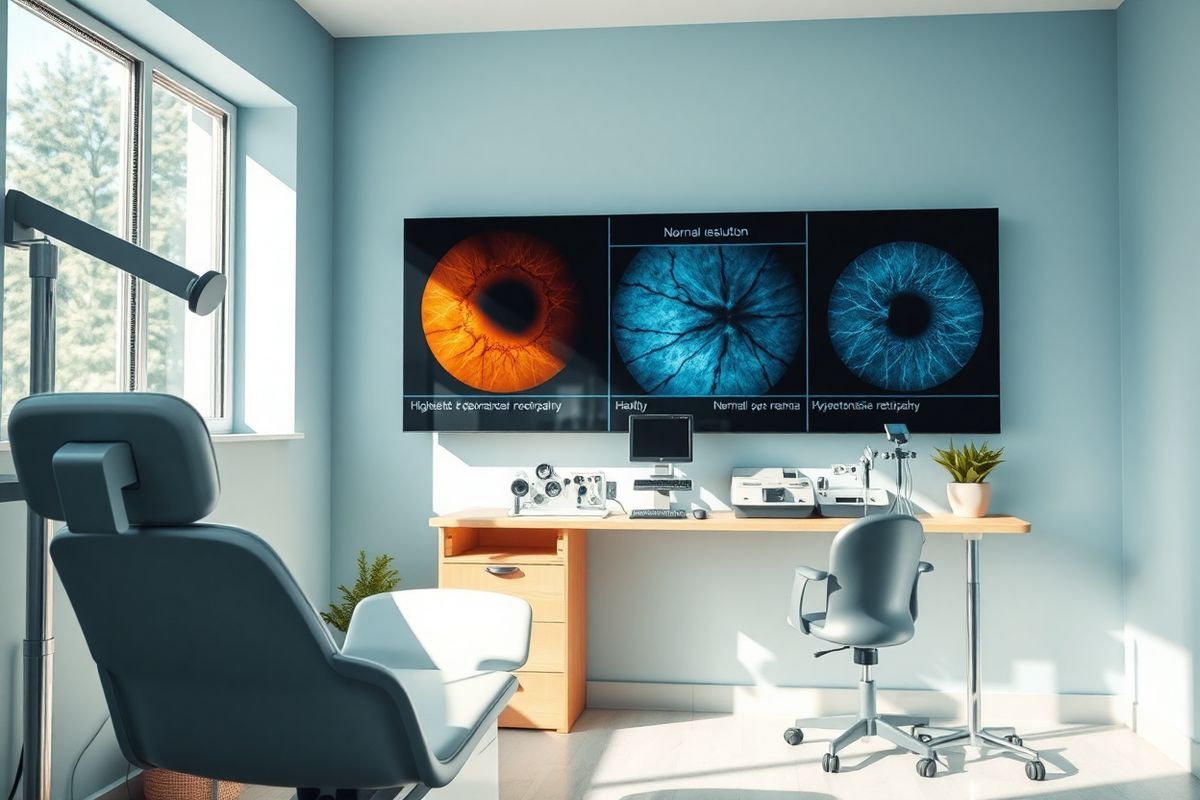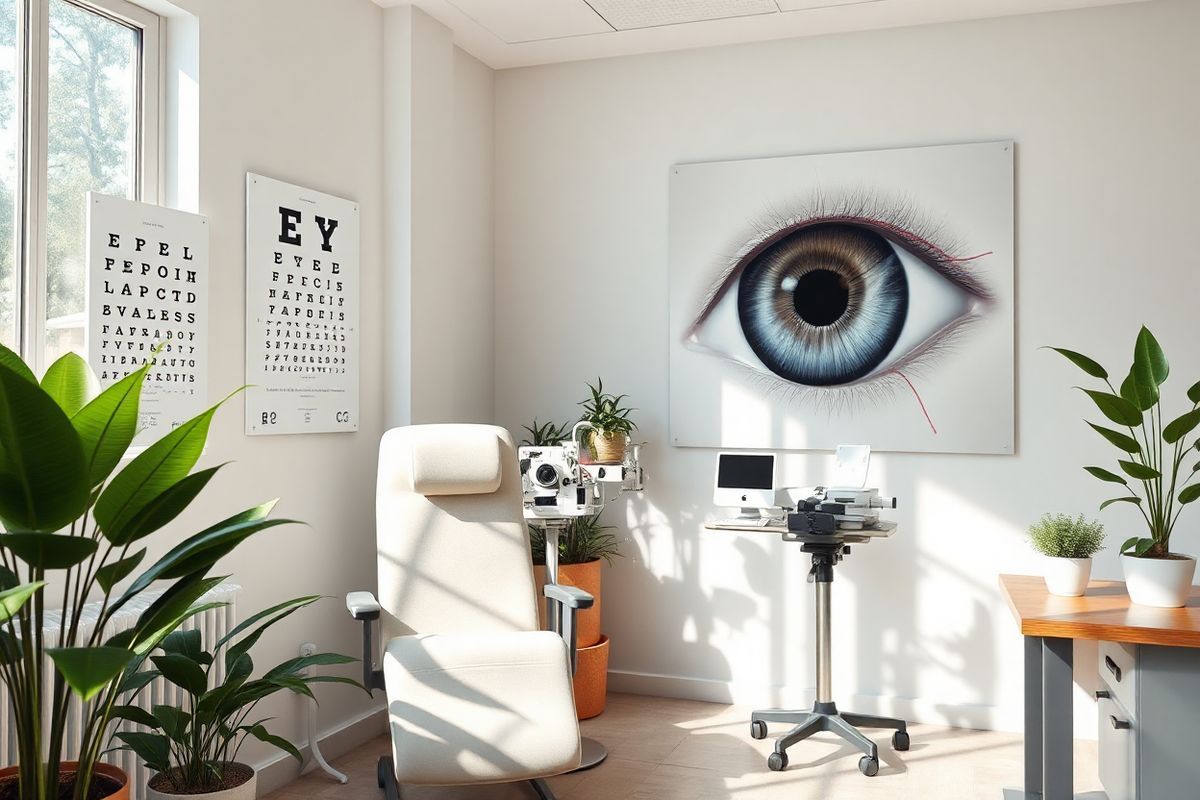Table of Contents
Understanding retinopathy: Types, Causes, and Symptoms

retinopathy refers to damage to the retina, the light-sensitive tissue at the back of the eye, which can lead to vision impairment or blindness. The most common types are diabetic retinopathy and hypertensive retinopathy. Diabetic retinopathy occurs due to prolonged high blood sugar levels that damage the blood vessels in the retina, while hypertensive retinopathy results from chronic high blood pressure affecting the retinal blood vessels.
Types of Retinopathy
-
Diabetic Retinopathy: This is a complication of diabetes characterized by changes in the blood vessels of the retina. It can be classified into two main stages:
- Nonproliferative Diabetic Retinopathy (NPDR): Early stage where blood vessels leak fluid or bleed, leading to retinal swelling and possibly macular edema.
- Proliferative Diabetic Retinopathy (PDR): Advanced stage where new, abnormal blood vessels grow on the retina’s surface, which can lead to severe vision loss (American Society of Retina Specialists, 2023).
-
Hypertensive Retinopathy: This occurs when high blood pressure causes changes in the retinal blood vessels. It is classified into four stages based on the severity of the changes:
- Mild: Arteriolar narrowing and changes in the retinal arteries.
- Moderate: More pronounced changes including cotton wool spots and retinal hemorrhages.
- Severe: Severe narrowing of the arteries and extensive retinal bleeding.
- Malignant: Presence of retinal exudates and potential vision loss (Medical News Today, 2023).
Causes and Symptoms
Both diabetic and hypertensive retinopathy share common risk factors, including:
- High blood sugar levels (for diabetic retinopathy)
- Chronic hypertension (for hypertensive retinopathy)
- Obesity
- Sedentary lifestyle
- Smoking
Symptoms may not be noticeable until significant damage has occurred. Common signs include:
- Blurred or distorted vision
- Floaters or dark spots in the vision
- Difficulty perceiving colors
- Shadows or areas of darkness in the field of vision (Cleveland Clinic, 2023).
The Connection Between Hypertension and Retinopathy: What You Need to Know

Hypertension is closely linked to retinopathy, primarily through its damaging effects on blood vessels. High blood pressure can lead to changes in the retinal blood vessels similar to those seen in diabetic patients. This connection emphasizes the need for regular eye examinations in individuals with high blood pressure or diabetes.
Mechanisms Linking Hypertension and Retinopathy
- Vascular Damage: Chronic hypertension can cause the blood vessels in the retina to thicken and narrow, reducing blood flow and leading to ischemia.
- Increased Vascular Permeability: High blood pressure may increase the permeability of retinal blood vessels, causing fluid leakage into the retina.
- Neovascularization: In response to ischemia, new blood vessels may form, contributing to further complications such as hemorrhage and scarring (Hypertension and Diabetes Connection, 2023).
Risk Factors for Hypertensive Retinopathy
Individuals with hypertension often have other risk factors that contribute to retinal damage, including:
- Diabetes
- High cholesterol
- Smoking
- Family history of eye diseases
Diabetic Retinopathy: Risk Factors and Warning Signs
Diabetic retinopathy is a leading cause of blindness in adults, with its incidence increasing alongside the prevalence of diabetes. Understanding the risk factors and early warning signs can help in early detection and management.
Key Risk Factors
- Duration of Diabetes: The longer a person has diabetes, the higher the risk of developing retinopathy.
- Poor Blood Sugar Control: Elevated blood glucose levels can accelerate the progression of retinopathy.
- Hypertension: Coexisting hypertension significantly increases the risk of developing diabetic retinopathy (American Society of Retina Specialists, 2023).
- Hyperlipidemia: High cholesterol levels can also contribute to the progression of diabetic retinopathy (Cleveland Clinic, 2023).
Warning Signs
Early signs of diabetic retinopathy may not be noticeable without a comprehensive eye exam. However, potential warning signs include:
- Blurred vision
- Difficulty reading or seeing distant objects
- The appearance of floaters
- Sudden changes in vision (Diabetic Retinopathy, 2023).
Comparing Hypertensive and Diabetic Retinopathy: Key Differences and Similarities
While both diabetic and hypertensive retinopathy affect the retina, they differ in their etiology, progression, and management.
Similarities
- Both conditions can lead to vision loss if not managed properly.
- Early stages of both retinopathies may be asymptomatic.
- Both are influenced by systemic health factors such as diabetes, obesity, and hypertension.
Differences
| Feature | Diabetic Retinopathy | Hypertensive Retinopathy |
|---|---|---|
| Primary Cause | Prolonged high blood sugar levels | Chronic high blood pressure |
| Stages | NPDR and PDR | Mild, Moderate, Severe, Malignant |
| Symptoms | Blurred vision, floaters, difficulty seeing color | Blurred vision, sudden vision loss |
| Management | Blood sugar control, laser treatment, injections | Blood pressure control, lifestyle changes |
Understanding these differences can help healthcare providers tailor treatment strategies for individuals at risk for these conditions.
Effective Management Strategies for Retinopathy: Prevention and Treatment Options
Managing retinopathy effectively involves both prevention strategies and treatment options.
Prevention Strategies
- Regular Eye Exams: Individuals with diabetes or hypertension should undergo annual eye examinations to detect early signs of retinopathy.
- Blood Sugar Control: Maintaining optimal blood glucose levels can reduce the risk of developing diabetic retinopathy.
- Blood Pressure Management: Keeping blood pressure within recommended limits can help prevent hypertensive retinopathy.
- Healthy Lifestyle Choices: Engaging in regular physical activity, maintaining a healthy weight, and following a balanced diet can reduce risk factors associated with both conditions (Medical News Today, 2023).
Treatment Options
Diabetic Retinopathy
- Laser Therapy: Used to treat proliferative diabetic retinopathy, helping to reduce the risk of vision loss.
- Anti-VEGF Injections: These medications can reduce swelling and prevent the growth of abnormal blood vessels.
- Vitrectomy: A surgical procedure to remove blood or scar tissue from the eye (American Society of Retina Specialists, 2023).
Hypertensive Retinopathy
- Blood Pressure Medications: ACE inhibitors, beta-blockers, and diuretics can help manage hypertension.
- Lifestyle Modifications: Reducing salt intake, increasing physical activity, and managing stress can improve blood pressure control (Diabetes and High Blood Pressure, 2023).
References
- American Society of Retina Specialists. (2023). Diabetic retinopathy. Retrieved from https://www.asrs.org/diabeticretinopathy
- Cleveland Clinic. (2023). Diabetes and High Blood Pressure. Retrieved from https://www.hopkinsmedicine.org/health/conditions-and-diseases/diabetes/diabetes-and-high-blood-pressure
- Medical News Today. (2023). Diabetes and hypertension: Connection, complications, risks. Retrieved from https://www.medicalnewstoday.com/articles/317220
FAQ
Q: What is retinopathy? A: Retinopathy is an eye condition that affects the retina, often caused by diabetes or high blood pressure, leading to vision impairment.
Q: How can I prevent diabetic retinopathy? A: Regular eye exams, maintaining healthy blood sugar levels, and managing hypertension can help prevent diabetic retinopathy.
Q: What are the symptoms of hypertensive retinopathy? A: Symptoms may include blurred vision, sudden vision loss, and visual distortions. Regular eye exams are essential for early detection.
Q: What treatments are available for retinopathy? A: Treatment options include laser therapy, anti-VEGF injections, and vitrectomy for diabetic retinopathy; blood pressure medications and lifestyle changes for hypertensive retinopathy.











